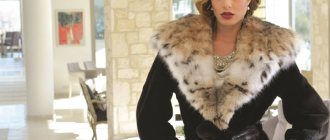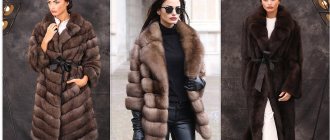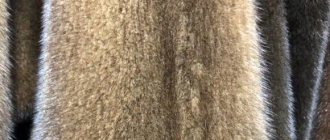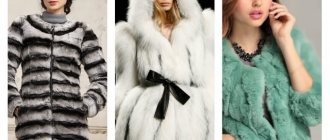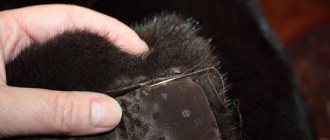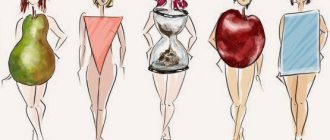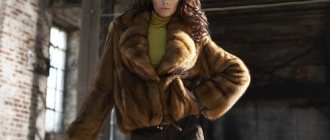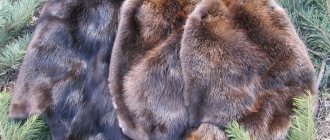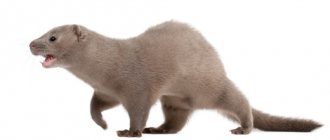When choosing a mink coat, you have to decide many questions regarding color, quality, and style. And so you try on a model - one, another, a third... A diligent and conscientious seller informs you that this model is made of plucked mink, and this one is sewn open, and this one is sewn with plates, etc. An unprepared buyer is lost in the choice: What does it mean for a fur coat to be loose or in plates? Which is better? What are the pros and cons? To answer these questions, let’s consider, first of all, what “fur coat in dissolution” means.
Choosing a fur coat to wear
Features of cut and style
A mink coat cut into pieces is a special cutting of a fur coat, when whole pieces of skin are cut completely or partially into narrow strips with a width of 0.4 cm to 10 cm diagonally, and then these strips are sewn together in a straight or oblique line along the entire length of the product. The fact is that mink skins themselves are short, and their length is not enough to sew a fur coat. In addition, mink skins are heterogeneous, unequal in size and quite difficult to fold into a single product. And sewing in a loose fit allows you to almost perfectly match the style to the fur fabric.
Mink coat
The unraveled skin from the inside looks like a herringbone, but from the outside it seems like it is a single piece. If the seams are visible from the outside, this means that the product is of poor quality and the seams will soon begin to fall apart. Mink coats in dissolution are most often sewn with flowing, loose or trapezoidal silhouettes, when the expansion comes from the shoulder blades. Moreover, it is simply impossible to sew a trapezoidal model any other way. But this model perfectly follows your silhouette, as if flowing along the body, it is soft, airy and very dynamic. This cut allows you to bring to life the most complex and daring design ideas. In this regard, a loose mink fur coat compares favorably with models sewn from plates or using the one-piece method, which are less mobile and streamlined.
Furrier technology
Cross-stitching is an increase in the size of a hide (or part of a hide) by inserting narrow strips that partially change its shape. Cross-stitching can significantly improve the appearance of the hide.
Jointing is done in different ways. If the stitching was not preceded by a transfer, then to sew in the stitching material it is enough to cut the leather fabric and slightly push its edges apart. It must be remembered that trimming downy hair is unacceptable.
For stitching, the skins of polar fox, blue fox, and polar hare are used. However, with the help of strips of different widths and their arbitrary number, you can embroider other skins.
Trimming is carried out only on topographic areas of the skin with thick downy hair. The rump, belly, flank, and often the backbone cannot be used for trimming.
To make a scarf from white fox skin, cut lines are applied to it at a distance of 10-15 mm (Fig. 12) at an angle of 60° to the spine line. For this skin, a horizontal jointing method was used, which makes it possible to better (taking into account the properties of the hair) use the parts of the skin intended for this purpose. The width of the joints can vary from 5 to 10 mm, sometimes more, depending on the size and quality of the fox skin. When calculating the length obtained during jointing, it is necessary to take into account the loss of area for seams, components; approximately 1 mm for each seam.
The lining material used is velvet braid or similar material, which is cut into strips of appropriate width.
Rice. 12. Schemes for cutting skins (a) using diagonal (b, c), transverse (d) and wedge (e) jointing.
You can also use the so-called air jointing method (this method is also called perforation ) (Fig. 13). To do this, the skin is drawn with horizontal lines at a distance of 10 mm. Then, after 10-15 mm in the transverse direction, short notches are made, each of which should be shifted relative to the previous one. In this way a regular mesh is obtained. Then the moistened skin is stretched to a certain length. The increase in length can be half the original length of the skin. With this operation, the width of the skin decreases, but its area increases. Since the side sections are not perforated, this allows the straightening process to be carried out. It is recommended to duplicate the perforated areas.
Rice. 13. Examples of perforation (a; b).
Jointing with changes in the length and width of the skin is performed using oblique notches. The density of the notches depends on the quality of the skin. The notches are parallel to each other, but offset in relation to those made earlier. The length of the notches is about 4 mm.
The considered jointing methods are used for different types of skins.
- Back
- Forward
What are the benefits of a mink coat when dissolved - pros and cons
Judging by the reviews of experts and buyers, there are many both supporters and opponents of buying a mink coat in dismantling. As a rule, the truth is in the middle, and the advantages of dissolution can easily turn into disadvantages and vice versa. When sewing fur coats into loose fur, the skins are moistened and stretched for elasticity and greater length. In this case, everything depends on the conscientiousness of the performers: the skin can be stretched to such an extent that it loses all strength, and the fur coat will simply begin to fall apart after a couple of seasons.
Proponents of the dissolving technology, on the contrary, say that a skin that has withstood pre-stretching is a guarantee of strength. In this case, the weight of the product can serve as a criterion: if the fur coat is too light, it means that the skins are overstretched. The same applies to seams. In the unraveling model, there are a lot of seams, and it all depends on their quality: self-respecting well-known companies make strong, even seams, without gaps, almost invisible. In such a product, first of all, pay attention to the seams - otherwise it will not be worn for a long time. The strongest unraveling seams are obtained when the seam is not made end-to-end, but the edges of the skin are lightly caught. At the same time, fur consumption increases, and the price will be much higher, but the quality is excellent. It happens that strips of fur are not sewn together, but glued together. This is the lowest quality; such a product risks falling apart after the first season. However, one should not think that a fur coat in dissolution is necessarily sewn from assorted pieces, as they say, “from the floor”, and even poorly colored.
Often in such products the best pieces of one tone are selected very carefully. It's no secret that loose models are often tinted to achieve a more uniform color. Here again, everything depends on the quality of the paint, which is easy to check. Sewing a fur coat to dissolve is more expensive due to complex technology. Hence the higher cost, which can be considered a disadvantage. However, according to experts, this high cost does not exceed 5%, which is hardly significant for those who are ready to invest in such an expensive and prestigious purchase.
The undoubted advantages of products in dissolution include the fact that its flowing unique beauty, valuable in itself, can hide any figure flaws. This is especially true for overweight and large women, who easily become slender and elegant in such a model.
Minor disadvantages include the fact that it is almost impossible to alter it, but only to shorten it. To small ones - because the styles of such fur coats are so good and versatile that they are unlikely to get boring. Experts also advise being careful when dry cleaning fur coats.
To summarize, we can say that good quality loose fur coats are in no way inferior and even superior in their parameters to models sewn with plates or one-piece.
Mink coats in dissolution - photo options
As we have already noted, trapezoidal and airy, “flying” models are always in fashion; they are already classics of the fur genre. This is especially true for such styles as bell, trapeze, butterfly, ballet shoes (see photo options). Here are classic examples from the best manufacturers in our styles section. Trapezoid is one of the most common options. Collar - any, a shawl and a hood are appropriate - length, as a rule, is 100 - 110 cm. A loose-fitting model, with or without a belt, both a large turn-down collar and an English collar are appropriate (photo). Length - 100 - 110 cm or more.
Black and white Chanel sheepskin coats, bell-shaped, with 3/4 sleeves look chic. Length - 90 - 100 cm. Classic options - ballet shoes, widening immediately from the shoulder line, medium length, stand-up collar, maybe a hood - large or small.
But “butterflies”, autoladies or simply short capes up to the hips, with one or two stylish buttons, can also create a sensation, like all the fur coats in this category - flying, airy, chic (photo). Even a straight swinger with a hood, and sometimes other straight fur coat classics, is made from mink in loose form and looks very original, although such fur coats are often made from whole skins. As you can see, mink coats come in a wide variety of quality - from magnificent and high-quality to, to put it mildly, not very good.
In order not to make a mistake in your choice, be guided not only by our advice, but also by your intuition, as customers say in reviews, it will never let you down.
Leave your comment:
How to check the quality of fur coats made from plates
It is worth checking the reverse side or running it against the pile, this will help determine the quality of the seams. Sometimes the fur is not sewn together at all, but glued together; these are the lowest-grade fur coats that fall apart in the second season. There is also such a thing as computer assembly. The plates are selected using special programs, then the fur coats look more impressive and fit well.
Coats or long fur coats are not made from plates; more often these are models with a straight or fitted silhouette, short and medium length.
It is important to understand that a fur coat made from solid plates is not a model made from pieces. The plates have a certain size, and the pieces are scraps and leftovers; cheaper fur coats are made from them, because the raw materials are cheaper.
How to check the quality of fur coats made from plates
What determines the cost of fur products?
First you need to decide what a new fur coat is for.
To reliably protect you from the piercing wind and severe cold for many seasons? - Choose the expensive one.
Or do you want to be at the “peak” of fashion and add an elegant model to your wardrobe? In this case, the fur coat will serve for 3-4 years, not wearable, but stylish and inexpensive.
The cost of the selected product depends, first of all, on the dressing and high quality of the skins. Fur coats made from this type of fur are flexible and easily fit the figure. When shaking and squeezing, no rustling is heard. They do not emit an unpleasant odor.
The underside of the skin (mezra) is velvety and light, slightly stretchy. This means that the skins are not overdried and will not tear.
The pile is shiny, soft, even, and does not crumble. The underfur is thick, there are no bald patches. If you pull it apart, the skin is not visible. Short guard hair is a sign of high-quality and more expensive fur.
The geographical location of fur farms also determines the cost.
For example, Scandinavian, North American and Russian mink are the most valuable. You can verify the integrity of the manufacturer and seller if you find the address on its website.
There should be quality certificates from international fur auctions where large enterprises purchase raw materials. The fleece is also evaluated there.
How expensive a fur coat is depends on whether it is sewn in a specialized studio or in a factory. Length, width, style and size are taken into account. It is clear that for a coat of size 42-44 you will need less skins than for a size 52-54.
The color shade is another indicator of the cost of a fur coat. The lighter the fur, the more expensive the product. White tones are the most valuable, since it is difficult to raise an animal with this color.
White mink is also expensive. However, dark mink coats are more expensive than light ones. Average cost - from light tones (walnut, pastel, gold, cross, sapphire, pearl) to chocolate (mahogany).
The most prized are black mink coats (scanblack, blackglama, blacknafa).
The method used to assemble the fur coat (from plates, from pieces of fur or from strips) is also included in the price. It is easier to assemble a coat from whole skins, and it lasts longer.
Coats assembled by master hands from pieces of fur are unique! And at the same time affordable.
Sewing a product with loose fabric (from strips) is painstaking, expensive work. But in this way they achieve a special hair play, lightness and beauty!
